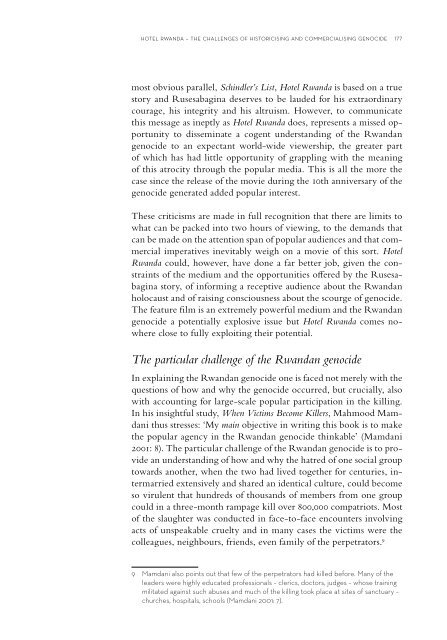60 years after the UN Convention - Dag Hammarskjöld Foundation
60 years after the UN Convention - Dag Hammarskjöld Foundation
60 years after the UN Convention - Dag Hammarskjöld Foundation
You also want an ePaper? Increase the reach of your titles
YUMPU automatically turns print PDFs into web optimized ePapers that Google loves.
hotel rwanda – <strong>the</strong> challenges of historicising and commercialising genocide 177<br />
most obvious parallel, Schindler’s List, Hotel Rwanda is based on a true<br />
story and Rusesabagina deserves to be lauded for his extraordinary<br />
courage, his integrity and his altruism. However, to communicate<br />
this message as ineptly as Hotel Rwanda does, represents a missed opportunity<br />
to disseminate a cogent understanding of <strong>the</strong> Rwandan<br />
genocide to an expectant world-wide viewership, <strong>the</strong> greater part<br />
of which has had little opportunity of grappling with <strong>the</strong> meaning<br />
of this atrocity through <strong>the</strong> popular media. This is all <strong>the</strong> more <strong>the</strong><br />
case since <strong>the</strong> release of <strong>the</strong> movie during <strong>the</strong> 10th anniversary of <strong>the</strong><br />
genocide generated added popular interest.<br />
These criticisms are made in full recognition that <strong>the</strong>re are limits to<br />
what can be packed into two hours of viewing, to <strong>the</strong> demands that<br />
can be made on <strong>the</strong> attention span of popular audiences and that commercial<br />
imperatives inevitably weigh on a movie of this sort. Hotel<br />
Rwanda could, however, have done a far better job, given <strong>the</strong> constraints<br />
of <strong>the</strong> medium and <strong>the</strong> opportunities off ered by <strong>the</strong> Rusesabagina<br />
story, of informing a receptive audience about <strong>the</strong> Rwandan<br />
holocaust and of raising consciousness about <strong>the</strong> scourge of genocide.<br />
The feature fi lm is an extremely powerful medium and <strong>the</strong> Rwandan<br />
genocide a potentially explosive issue but Hotel Rwanda comes nowhere<br />
close to fully exploiting <strong>the</strong>ir potential.<br />
The particular challenge of <strong>the</strong> Rwandan genocide<br />
In explaining <strong>the</strong> Rwandan genocide one is faced not merely with <strong>the</strong><br />
questions of how and why <strong>the</strong> genocide occurred, but crucially, also<br />
with accounting for large-scale popular participation in <strong>the</strong> killing.<br />
In his insightful study, When Victims Become Killers, Mahmood Mamdani<br />
thus stresses: ‘My main objective in writing this book is to make<br />
<strong>the</strong> popular agency in <strong>the</strong> Rwandan genocide thinkable’ (Mamdani<br />
2001: 8). The particular challenge of <strong>the</strong> Rwandan genocide is to provide<br />
an understanding of how and why <strong>the</strong> hatred of one social group<br />
towards ano<strong>the</strong>r, when <strong>the</strong> two had lived toge<strong>the</strong>r for centuries, intermarried<br />
extensively and shared an identical culture, could become<br />
so virulent that hundreds of thousands of members from one group<br />
could in a three-month rampage kill over 800,000 compatriots. Most<br />
of <strong>the</strong> slaughter was conducted in face-to-face encounters involving<br />
acts of unspeakable cruelty and in many cases <strong>the</strong> victims were <strong>the</strong><br />
colleagues, neighbours, friends, even family of <strong>the</strong> perpetrators. 9<br />
9 Mamdani also points out that few of <strong>the</strong> perpetrators had killed before. Many of <strong>the</strong><br />
leaders were highly educated professionals – clerics, doctors, judges – whose training<br />
militated against such abuses and much of <strong>the</strong> killing took place at sites of sanctuary –<br />
churches, hospitals, schools (Mamdani 2001: 7).

















